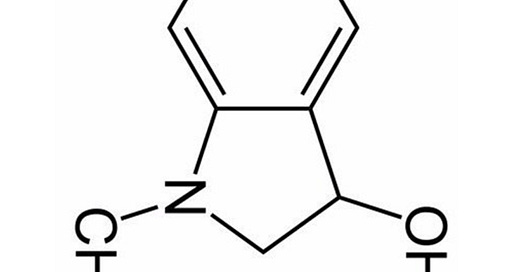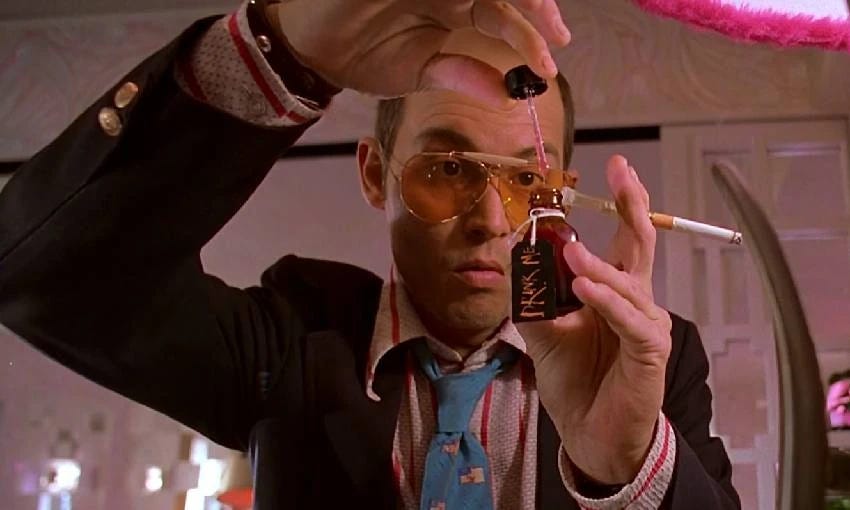

Discover more from JuliansRum’s Substack

For years, adrenochrome was one subject I was reluctant to take a public position on. Not because I thought it was fake. Adrenochrome as a compound is 100% real. I just wasn’t convinced it was really used as a drug by the global elite farmed from tortured children.
I knew they tortured children, but I wasn’t sure adrenochrome was one of their motivations for doing it. For whatever reason, it was much easier to accept that they did such abominable things simply for the purposes of sadistic enjoyment and blackmail.
But I began to realize my skepticism of adrenochrome as a drug wasn’t nearly as justified as I thought.
I started taking the subject more seriously in 2021 when Jim Caviezel mentioned the “adrenochroming of children” while he was promoting his film “Sound of Freedom.” He later elaborated on it in an interview with Steve Bannon, where he described adrenochrome as “an elite drug that they’ve used for many years. It’s ten times more potent than heroin. And it has some mystical qualities as far as making you look younger. ‘Ambrosia’ is the street term - well, the elite term.”
Then Tim Ballard, the former Homeland Security agent on which “Sound of Freedom” is based, touched on the underground adrenochrome industry in an interview with Jordan Peterson: “They’re taking children’s blood and devouring it. It’s very real, this witchdoctory. They take these children, they take their organs, they take their blood, they drink it.”
Whew. These were bold statements I couldn’t ignore.
So I started digging and eventually found what I was looking for: verified scientific research which documents experiments with adrenochrome as a hallucinogenic drug.
Before we dive into that eye-opening research, let’s establish what adrenochrome is and a brief rundown of its history.
What is Adrenochrome?
Adrenochrome is a derivative of the fight-or-flight hormone adrenaline which is produced in the adrenal glands above the kidneys as a response to perceived danger/trauma.
When the body is subjected to extreme stress, it releases adrenaline into the bloodstream. This rapidly increases the heart and respiratory rate, providing muscles with enough energy to quickly and powerfully contract.
When subjected to extreme trauma, the body suffers what’s called oxidative stress and produces negatively charged oxidants such as superoxide. During prolonged physical torture, the body produces an excess of both adrenaline and oxidants which interact to form the chemical compound of adrenochrome.
A Brief History of Adrenochrome
Since at least 1856, scientists have observed that fluids extracted from the adrenal medulla – the section of the adrenal gland which produces adrenaline – turn pink with prolonged exposure to oxygen.
In 1935, scientists crystalized this substance and dubbed it ‘adrenochrome’ – which means “colored adrenaline.” In 1942, adrenochrome was considered a potential remedy for high blood pressure.
During World War 2, Canadian field medics who were short on morphine would sometimes extract adrenaline from the adrenal glands of deceased soldiers, allowing it to degrade in the air before injecting its pink derivative into wounded soldiers. In addition to producing an anesthetic effect, the injection allegedly gave the wounded soldiers vivid hallucinations.
In 1952, three Canadian scientists based in Saskatchewan proposed a biochemical cause for schizophrenia and a potential treatment, which came to revolve around adrenochrome.
These scientists were Dr. Abram Hoffer, a Saskatchewan-born biochemist; Humphry Fortescue Osmond, an English-born psychiatrist; and John Raymond Smythies, an Indian-born neuroscientist.
In 1952, Smythies and Osmond worked at the Weyburn Mental Hospital in Saskatchewan where they experimented on mental patients by administering high doses of psychedelic drugs such as mescaline and LSD (It’s worth noting that this facility had links to CIA-funded projects).
In their paper “Schizophrenia: A New Approach,” Hoffer, Osmond, and Smythies noted the similarity between adrenaline and mescaline. From their previous human experimentation and experience, they observed that the consumption of mescaline produced a change in perception similar to that of schizophrenia.
They proposed that schizophrenia was caused by the body’s inability to metabolize a substance which the body naturally produces. They later identified this substance as adrenochrome.
During the 1950s, Osmond, Hoffer, and Smythies conducted research into adrenochrome, with an emphasis on how it affects human behavior. They were able to manufacture adrenochrome themselves, describing it as “beautiful crystals which were purplish red and formed a bright red solution which turned yellow when oxidized by the oxygen in the air.”
They also experimented on themselves and their wives by injecting adrenochrome into their veins. They published their experiences in a research paper where they described adrenochrome as a “more insidious and longer-lasting drug than both mescaline and LSD.”
This is the research I stumbled upon.
In “Some Psychological Effects of Adrenochrome: Hoffer, Osmond and Smythies” Osmond documents his personal experiences tripping on adrenochrome as well as the experiences of other volunteers.
What follows are what I deemed to be the most notable excerpts pulled from the research paper where Osmond recounts his experience tripping on adrenochrome. The research paper can be read in full here (pg 37-42).
Osmond’s Experience after Being Injected with Adrenochrome
The fact that my blood pressure did not rise suggests that I was not unduly tense. After about 10 minutes, while I was lying on a couch looking up at the ceiling, I found that it had changed color. It seemed that the lighting had become brighter. I asked Abe and Neil if they had noticed anything, but they had not. I looked across the room and it seemed to have changed in some not easily definable way. I wondered if I could have suggested these things to myself.
I closed my eyes and a brightly colored pattern of dots appeared. The colors were not as brilliant as those which I have seen under mescaline but were of the same type. The patterns of dots gradually resolved themselves into fish-like shapes. I felt that I was at the bottom of the sea or in an aquarium among a shoal of brilliant fishes. At one moment I concluded that I was a sea anemone in this pool.
Abe and Neil kept pestering me to tell them what was happening, which annoyed me. They brought me a Van Gogh self-portrait to look at. I have never seen a picture so plastic and alive. Van Gogh gazed at me from the paper, crop-headed, with hurt, mad eyes and seemed to be three dimensional. I felt that I could stroke the cloth of his coat and that he might turn around in his frame. Neil showed me the Rorschach cards. Their texture, their bas relief appearance, and the strange and amusing shapes which I had never seen in the cards were extraordinary.
My experiences in the laboratory were, on the whole, pleasant, but when I left I found the corridors outside sinister and unfriendly. I wondered what the cracks in the floor meant and why there were so many of them. Once we got outdoors the hospital buildings, which I know well, seemed sharp and unfamiliar. As we drove through the streets the houses appeared to have some special meaning, but I couldn't tell what it was. In one window I saw a lamp burning and I was astonished by its grace and brilliance. I drew the experimenters' attention to it, but they were unimpressed.
We reached Abe's home where I felt cut off from people but not unhappy. I knew that I should be discussing the experience with Abe and his wife but could not be bothered to do so. I felt no special interest in the experiment and had no satisfaction at its success, although I told myself that it was very important. Before I got to sleep I noticed that the colored visions returned when I shut my eyes. (Normally I have hypnagogic visions after several minutes in a darkened room when I am tired.) I slept well.
The next morning, although I had only slept a few hours, life seemed good. Colors were bright and my appetite keen. I was completely aware of the possibilities arising from the experiment. Color had extra meaning for me. Voices, typewriting, any sound was very clear. With those whom I felt did not appreciate the importance of the new discovery I could have easily become irritable, but I was able to control myself.
I had 5 mgm of adrenochrome this time because it was thought that it was probably deteriorating. I saw only a few visual patterns with my eyes closed. I had the feeling that there was something wonderful waiting to be seen but somehow I couldn't see it. However, in the outside world everything seemed sharper and the Van Gogh was three dimensional. I began to feel that I was losing touch with everything.
My sister telephoned and, although I am usually glad to hear her voice, I couldn't feel any warmth or happiness. I watched a group of patients dancing and, although I enjoy watching dancing with the envious interest of one who is clumsy on his feet, I didn't have a flicker of feeling.
As we drove back to Abe's house a pedestrian walked across the road in front of us. I thought we might run him down, and I watched with detached curiosity. I had no concern for the victim. We did not knock him down.
I began to wonder whether I was a person anymore and to think that I might be a plant or a stone. As my feeling for these inanimate objects increased my feeling for and my interest in humans diminished. I felt indifferent towards humans and had to curb myself from making unpleasant personal remarks about them. I had no inclination to say more or less than I observed. If I was asked if I liked a picture I said what I felt and disregarded the owner's feelings.
I did not wish to talk and found it most comfortable to gaze at the floor or a lamp. Time seemed to be of no importance. I slept well that night and awoke feeling lively, but although I had to attend 3 meetings that morning, I did not hurry myself. Eventually I had to be dragged out of the house by Abe.
I had to get my car from a garage where it was being repaired. When at last I was seated in the driver’s seat I realized that I couldn't drive it through traffic, although I’m quite able to do so usually. I did not, however, feel anxious or distressed by this but persuaded the garage proprietor to drive me to my destination. I would, I believe, have normally found this to be a humiliating situation. I did not feel humiliated.
I attended the scientific meeting, and during it I wrote this note: “Abe, this damn stuff is still working. The odd thing is that stress brings it on, after about 15 minutes. I have this 'glass-wall-other-side-of-the-barrier' feeling. It is fluctuant, almost intangible, but I know it is there. It wasn't there three quarters of an hour ago; the stress was the minor one of getting the car. I have a feeling that I don't know anyone here; absurd but unpleasant. Also some slight ideas of reference arising from my sensation of oddness. I have just begun to wonder if my hands are writing this, crazy of course."
I fluctuated for the rest of the day. While being driven home by a psychologist colleague I discovered that I could not relate distance and time. I would see a vehicle far away on the long, straight prairie roads, but would be uncertain whether we might not be about to collide with it. We had coffee at a wayside halt and here I became disturbed by the covert glances of a sinister looking man. I could not be sure whether he was really doing this or not.
I went out to look at two wrecked cars which had been brought into a nearby garage. I became deeply preoccupied with them and the fate of their occupants. I could only tear myself away from them with an effort. I seemed in some way to be involved in them.
Later in the day when I reached home the telephone rang. I took no notice of it and allowed it to ring itself out. Normally, no matter how tired I am, I respond to it.
By morning I felt that I was my usual self again.
To summarize the effects of Osmond’s experience tripping on adrenochrome:
- Intense audio-visual hallucinations
- Sharpened audio-visual perceptions
- Feelings of deep insight
- Feelings of unfamiliarity toward familiar surroundings
- Feelings of unfamiliarity toward familiar people
- Detachment from and disinterest in people
- Detachment from self
- Loss of empathy for people, including family members
- Thoughts of sociopathic/homicidal actions towards people
- Increased interest in morbid subject matter
- Intense interest in inanimate objects
- Identification as an inanimate object rather than a person
- Inability to properly perceive time and space
- Indifference to social norms
Keep in mind, Osmond claimed it was a modest dose but the trip appeared to last 48 hours. It’s also worth noting that Osmond, Hoffer and Smythies are somewhat vague as to how exactly they synthesized/obtained the adrenochrome they used.
I couldn’t find any references in their research to the reverse-aging effects that Jim Caviezel alluded to, but that doesn’t necessarily mean those don’t also exist.
All that said, this research conclusively proves that adrenochrome was and can be used as a powerful hallucinogenic drug. More disturbingly, it proves those under its influence turn into temporary sociopaths who are entirely detached from feelings of empathy. In fact, it seems to make them so comfortably detached that they become capable of unspeakable acts towards their fellow human beings.
One can only imagine what prolonged use of adrenochrome can do to one’s mind (and one’s humanity).
Another reference from Osmond that stuck out to me was his fish-like hallucinations:
“The patterns of dots gradually resolved themselves into fish-like shapes. I felt that I was at the bottom of the sea or in an aquarium among a shoal of brilliant fishes. At one moment I concluded that I was a sea anemone in this pool.”
I can’t help but wonder if these fish-like hallucinations are a common experience while tripping on adrenochrome. It reminds me of this drop in which Q highlights an old Disney Cruise Line snorkeling expedition to Epstein Island:
“Afterward, make your way to your second snorkel stop — Little St James Island — where curious fish dart back and forth in the clear blue water, and colorful coral formations nestle next to amazing underwater formations.”
What kind of expedition was Disney REALLY advertising?
Fish symbolism is something that frequently pops up in the cult elite’s symbolism. Recall the charm necklace that Gloria Vanderbilit wore when she was photographed with her two young sons. Notice the two fish charms on the bottom of the necklace which flank the ‘goddess’ charm in the photos below.
We all know Epstein Island was a blackmail honeypot where famous people were filmed committing unspeakable acts on children. But was it also used to farm and feed people’s addiction to adrenochrome?
The deeper we go…



















In plain sight.
The darkest path truths in the Info War will come back around. Always do.
Creepy…maybe this is partly an explanation for the one question I can never figure out: How can these people (deep state crazies) sleep at night knowing they are destroying the country that their kids and grandkids will inherit?